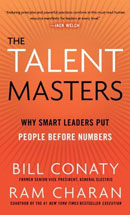Recommended Resource – The Talent Masters: Why smart leaders put people before numbers
The Talent Masters: Why Smart Leaders Put People Before Numbers
by Bill Conaty and Ram Charan
About the Reference
The Talent Masters: Why Smart Leaders Put People Before Numbers by Bill Conaty and Ram Charan provides unprecedented insight to the people development programs of several legendary organizations including General Electric, Proctor & Gamble, and Novartis. Conaty and Charan illustrate in great detail the specific programs these organizations use to develop talent and plan for and execute on succession plans; including the behind-the-scenes consideration of organizational, cultural, and operational impacts such changes incur. They also share their experience-based insights on the critical personal traits and organizational supports needed for succeeding leaders to excel in their new positions.
Benefits of Using this Reference
StrategyDriven Contributors like The Talent Masters because of its in-depth, behind-the-scenes insights to the talent management practices of globally recognized ‘leadership factories.’ Many case studies highlight the mechanics of these organizations’ programs but Conaty and Charan present the intimate executive discussions and thought processes on personnel development and succession that only insiders possess. This book captures the nuance of thought that makes these processes work so well at creating some of the world’s most sought after leaders.
The in-depth real-world business experience of leading companies presented in The Talent Masters makes this book on personnel development a StrategyDriven recommended read.


 Hank Moore has advised 5,000+ client organizations worldwide (including 100 of the Fortune 500, public sector agencies, small businesses and non-profit organizations). He has advised two U.S. Presidents and spoke at five Economic Summits. He guides companies through growth strategies, visioning, strategic planning, executive leadership development, Futurism and Big Picture issues which profoundly affect the business climate. He conducts company evaluations, creates the big ideas and anchors the enterprise to its next tier. The Business Tree™ is his trademarked approach to growing, strengthening and evolving business, while mastering change. To read Hank’s complete biography,
Hank Moore has advised 5,000+ client organizations worldwide (including 100 of the Fortune 500, public sector agencies, small businesses and non-profit organizations). He has advised two U.S. Presidents and spoke at five Economic Summits. He guides companies through growth strategies, visioning, strategic planning, executive leadership development, Futurism and Big Picture issues which profoundly affect the business climate. He conducts company evaluations, creates the big ideas and anchors the enterprise to its next tier. The Business Tree™ is his trademarked approach to growing, strengthening and evolving business, while mastering change. To read Hank’s complete biography,  Dave Anderson, author of
Dave Anderson, author of  Decades ago, an individual typically had the opportunity to work for their entire career within one company. Times have changed. Process automation and streamlining as a form of cost reduction has driven corporate rightsizing; eliminating the lifelong job security of times past and heightening employment risk. Combined with evolving employee tastes and a need to increase productivity, talent development takes on new importance.
Decades ago, an individual typically had the opportunity to work for their entire career within one company. Times have changed. Process automation and streamlining as a form of cost reduction has driven corporate rightsizing; eliminating the lifelong job security of times past and heightening employment risk. Combined with evolving employee tastes and a need to increase productivity, talent development takes on new importance. Bill Humbert is an expert Recruitment Consultant with 30 years’ experience in the field. In his consulting business
Bill Humbert is an expert Recruitment Consultant with 30 years’ experience in the field. In his consulting business